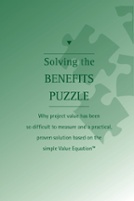Tangible Means More Than Just ‘Financially' Measurable
In response to a raft of useless, unmeasurable ‘strategic’ benefits seen in project business cases in the last two decades, there is a strong view nowadays that only ‘tangible’ — by which is meant ‘financial’ — benefits are valid.
Indeed, many business cases have headings of “Tangible” and “Intangible” benefits based on this mistaken understanding of the meaning of the word ‘tangible’.
“Tangible” correctly means “measurable” i.e., if a benefit is measurable, then it is tangible. If you can measure an increase in your client’s satisfaction or loyalty, then it is tangible.
In the TOP Value Equation, we define Benefits as the positive consequences of achieving the Outcomes that have been defined and Value as the measure of these benefits measured by:
- money e.g. in the bank or through changes in the financial accounts
- key performance indicators e.g. error rates
- proxy measures e.g. net promotor score
- or observed - you can see it but it is hard or not worth counting it.
All benefits must be measurable (tangible in the true sense) otherwise you’ll never know if you have achieved them.
Simple.
However, this also that the value of a benefit can also mean something other than financial i.e., money. It can be measured by increases in ratings, benchmark positions, retention statistics, and other measures.
I often used to illustrate this point with CFOs by asking them if they own a car; then demonstrating that owning a car is a financial disaster but that the reasons why we do it, the benefits, are non-financial — comfort, convenience, prestige, safety, etc. Mostly these benefits are ‘measured’ non-consciously rather than formally. But they are seen as of sufficient value for us to spend our own money on a car when measured in strictly financial terms, using taxis, public transport and the occasional hire car is far more cost-effective.
-Jed Simms
This is an important insight in that it changes the debate as to what is eligible and therefore worthwhile pursuing in terms of benefits. It also increases the financial value of your benefits as you can often ‘translate’ some of the non-financial benefits (e.g. increased customer retention) into monetary value.
But, if - incorrectly - you only believe that only financial benefits are "valid", you’ll not look twice at a non-financial benefit.
For example, a steel company identified that its new warehouse system would reduce the movement of stock within the warehouse. As this was a non-financial benefit it was ignored (listed under ‘intangible benefits’). When questioned, and asked about the impact of reduced stock movement on reducing stock damage and stock obsolescence, suddenly, a non-financial benefit was found to have a value of over $5m pa.
We Need To Focus On All Tangible Benefits - Not Just Financial Ones
We need to discard this myopic financial benefits-only perspective, as this leads to a significant (greater than 25%) understatement of financial benefits!
Let’s instead look for all possible benefits, check they are measurable (discarding any that aren’t), and then, importantly, analyze the non-financial benefits to see where these too can deliver measurable value.
In Conclusion
Using this approach, we’ve seen projects identify what was assumed to be $6m of value from benefits, but then with more detailed analysis, this became $24m! — so it’s worth it.
Learn More About Project Benefits
You can buy our book from Amazon




